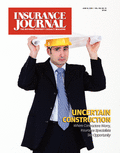Standard & Poor’s Ratings Services announced that it has assigned its preliminary “BB” senior debt, “BB-” subordinated debt, and “B+” preferred stock ratings to Fairfax Financial Holdings Ltd.’s (FFH) U.S.$750 million universal shelf offering.
“FFH has filed this shelf registration so that it may offer subordinated voting shares, preferred shares, debt securities, warrants and other securities with both the Canadian securities regulatory authorities and the U.S. SEC,” noted S&P credit analyst Damien Magarelli. “We are not expecting any significant amounts of incremental debt to be offered through this universal shelf.”
S&P noted: “At the same time, FFH has cancelled its previous universal shelf registration statement filed in March 2004, which had roughly $130 million in capacity remaining.
“The ratings on FFH and its member companies (collectively referred to as Fairfax) are based on the operating companies’ good competitive position and diversification in the U.S., Canada, and internationally. Operating performance has significantly improved in 2002 and 2003, though the runoff operations are still creating a significant drag on total company earnings.
“Underwriting profitability was maintained through third-quarter 2004 despite catastrophe losses, though total net earnings have decreased. FFH’s capital adequacy, financial flexibility, and investments are viewed as a strength of the rating.”
S&P also indicated that “offsetting these positive traits have been continuous reserve strengthenings, a dependence on realized gains to maintain earnings, high reinsurance recoverables, and a corporate strategy that has orchestrated some acquisitions that have not met expectations. In addition, FFH has historically maintained very high debt leverage.”
S&P said that because of the high amount of intangible assets, it “believes that debt (including trust preferreds) to tangible equity is an appropriate measure of financial leverage and was 50 percent as of third-quarter 2004.”
It added that the stable outlook is “based on the view that Fairfax should exhibit continued improvement in underwriting and capitalization in 2005. Also, liquidity concerns are minimal as the next material cash outlay consists of debt obligations due in April 2005 ($27 million). In addition, although future reserve strengthenings are expected, Standard & Poor’s expects that earnings, reinsurance, and realized capital gains can offset reserve charges in 2004. Fairfax’s ability to demonstrate an improving and sustainable track record in earnings, capital adequacy, and liquidity is extremely important for the company to potentially improve its existing rating and/or outlook.”
Was this article valuable?
Here are more articles you may enjoy.


 Senate Strikes AI Regulation Ban From Trump Megabill
Senate Strikes AI Regulation Ban From Trump Megabill  Racketeering Suit Alleges NY Insurance Fraud Scheme by Lawyers, Medical Providers
Racketeering Suit Alleges NY Insurance Fraud Scheme by Lawyers, Medical Providers  DeSantis Signs Law Giving Condo Owners Some Relief, But Questions Remain
DeSantis Signs Law Giving Condo Owners Some Relief, But Questions Remain  USC Basketball Star Alijah Arenas Recounts Tesla Cybertruck Crash
USC Basketball Star Alijah Arenas Recounts Tesla Cybertruck Crash 

